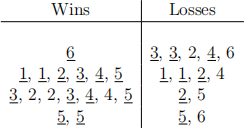MAT344H1Y– Problem Set 10 Introduction to Combinatorics
Hello, dear friend, you can consult us at any time if you have any questions, add WeChat: daixieit
MAT344H1Y– Problem Set 10
Introduction to Combinatorics
Due: August 2, 11PM
Complete the following exercises from the textbook in §10 but do not submit them for credit:
• do all the exercises in §10.
Complete the following problems for credit. You must link to the problems on Gradescope.
Answer all questions with full and complete explanations. The textbook is a good guide for what standard we are expecting of your explanations. Some questions may not be graded closely so that others may be focused on more closely in grading.
Make sure you give full explanations and justifications for all your answers. If you answers do not have that you will not get marks
1. Show that as n → ∞, the probability of k successes in a series of n Bernoulli trials with probability of success 1 /n is e−1/k!.
2. Suppose that X and Y are two random variables on the probability space (S, P), with E[X] = µX, and E[Y ] = µY . Define the covariance of X and Y as:
Cov(X, Y ) = E[(X − µX)(Y − µY )]
Note, we have Cov(X, X) = Var(X), and Cov(X, Y ) = Cov(Y,X) and Cov(aX1 + bX2, Y ) = a Cov(X1, Y ) + b Cov(X2, Y ).
(a) Show that if X and Y are independent random variables, (meaning P(X = a, Y = b) = P(X = a)P(Y = b) for all a, b 2 R, then Cov(X, Y )=0
(b) Suppose you flip a coin, and if it lands tails you flip another coin, and on heads do nothing. Let X be the random variable that is 1 if the first coin is heads, and 0 if the first coin is tails. Let Y be the random variable be 0 if the first coin is heads, and +1 if the second coin is heads, and −1 if the second coin is tails. Show that Cov(X, Y ) = 0, but X and Y are not independent random variables.
A summary of the outcomes and the random variables are presented in a table below:

3. Suppose you play a game with a (fair) six sided die, with sides 1, 2, 3, 4, 5, 6. The first time you roll, whatever you roll becomes the “set”. If the set is a 6, you win (and you stop rolling). If the set is anything other than 6, the set becomes the new “mark”. You then keep rolling until you either roll above the mark, in which case your lose (and you stop rolling), or you roll the mark, in which case the new mark becomes one plus the old mark, and you repeat this process. Whenever the mark becomes 6, you win (and you stop rolling). Calculate the probability that you win this game.
Some examples of winning games and losing games are below, with the sets and the times when you reach the mark underlined:

4. Suppose you a 20 sided fair dice until either you roll a 1 or a 20. If you roll a 20 you win, and you stop rolling, and if you roll a 1 you lose, and you stop rolling. If you roll 20 times without either a 1 or a 20 coming up, you win as well. What is the probability that you win?
5. Suppose (S, P) is a binomial distribution with n trials and probability of success p. Let X be the random variable X(k) = k3, where k is the number of successes. Calculate E[X].
2023-08-04